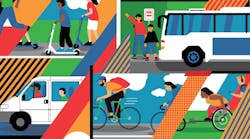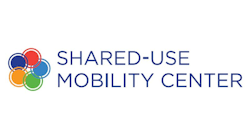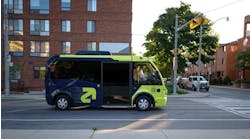OP-ED: Throwing good money after a bad solution: How our transport investments lead to greater costs for our households
It is no secret the U.S. prioritizes private vehicles over all other modes of transportation. This is on full display in the U.S. Department of Transportation’s fiscal year (FY) 2023 budget, with the Federal Highway Administration allocated more than double the funds compared to the Federal Transit Administration, but what we don’t as easily see are the repercussions of these investments and the trickle down effect this has on households. We are spending a lot of money on transportation only to create more dependence on private vehicles and therefore only increase the price to get around.
For instance, in FY 2020, the federal government allocated an estimated $46.4 billion for highway and road construction and maintenance, which was on par for an annual budget. We’ve spent just as much each year over the past few decades. That represents just a quarter of total government investments in transportation; the other three quarters of the public bill comes from state and local coffers. It would be great if all this spending lowered the cost of transportation for households, but it doesn’t.
Fifty years ago, U.S. households spent about seven to eight percent of their total budgets on transportation. By the late 2010s, that slice shot past 15 percent, and it continues to grow. In 2021 alone, U.S. households spent an aggregated $2.427 trillion to pay for transportation—mostly to get around by car. According to the Bureau of Transportation Statistics, this averaged out to $10,961 spent on transportation per household, or 16.4 percent of a household’s budget. Rural households had to spend more at $13,655, or 17.3 percent, of their budget.
Whether or not your household owns a car, you’re still paying a less-than-fair share for the infrastructure for cars. Our car-centric system demands parking everywhere, adding up to as much as two billion parking spaces in total throughout the country. All that space devoted to storing cars adds to the cost of goods we buy, the rent and mortgages we pay and the opportunity costs of land that could be more productive. A parking space also generates less taxes.
Meanwhile public transportation in the U.S., which has always struggled for funding, is facing a “fiscal cliff” as emergency pandemic support from the federal government runs out. TransitCenter and Transportation for America succinctly summarize the predicament:
"Transit agencies are facing a financial triple whammy – one-time payments from COVID-relief funding are drying up, fare collection has stabilized at well below pre-pandemic levels and expenses are growing because of inflation, tight labor markets and supply chain disruptions. As a result, most transit agencies are anticipating a steep, sudden operating budget deficit that will deepen annually, absent other forms of funding."
Privately run shared mobility services are also getting squeezed. Outside of investments in autonomous and electric vehicles, venture capital funding for shared mobility is getting scarce. Even mobility companies that are publicly traded are under stress.
Public transportation and shared mobility could significantly reduce households' dependence on private vehicles, which is why agenda item No. 6 of the Shared Mobility 2030 Action Agenda calls for “find(ing) and develop(ing) new, sustainable ways to fund more shared mobility” (including public transportation). The goal is to reduce household costs while addressing climate and equity.
The Action Agenda lays out multiple scenarios for shifting societal resources, so our transportation systems and transportation infrastructure reduce our household costs. For instance, using funds raised from fees or taxes on shared mobility to reinvest in additional mobility services and infrastructure or advocating to allocate capital funds into operations funds to expand shared mobility could all offer opportunities to address revenue shortfalls.
We’ve funded the expansion of infrastructure for cars for nearly a century and we continue to indirectly but significantly subsidize private car use through minimum parking requirements and other mandates on real estate development. We’re throwing good money after a bad solution.
Instead, we need to start investing public money into transportation systems that lower household costs. By expanding shared mobility and public transportation, we can connect more people to more opportunities in both urban and rural areas. We can create integrated networks of clean, accessible and equitable transportation services that give households more options, put more money back into people’s pockets and reduce their transportation cost burdens.
-------------
Benjie de la Peña is the CEO of Shared-Use Mobility Center.
--------------

Benjie de la Peña | CEO, Shared-Use Mobility Center (SUMC)
Benjie de la Peña is the CEO of the Shared-Use Mobility Center; he chairs the Global Partnership for Informal Transportation; founder of Agile City Partners; and writes and curates Makeshift Mobility, a fortnightly newsletter covering innovations in informal transportation. He also convenes the Shared Mobility 2030 Action Agenda and edits and produces Pop Transport.
He serves on the board of the American Council for an Energy-Efficient Economy (ACEEE), the U.S. Advisory Committee of the Institute for Transportation and Development Policy, the UITP Informal Transportation Working Group, the Digital Transport for Africa Partners Committee, the MobiliseYourCity Steering Committee and is a senior fellow for mobility for the Canadian Urban Institute.
He served as the first-ever chief of strategy and innovation for the Seattle Department of Transportation. He and his team drafted the city’s Transportation Information Infrastructure Plan. He also led the development of Seattle’s New Mobility Playbook.
He served on the advisory committees for L.A.’s Transportation Technology Strategy, the Mobiprize and Cooper Hewitt Museum’s The Road Ahead: Reimagining Mobility and Design with the Other 90%: Cities.




